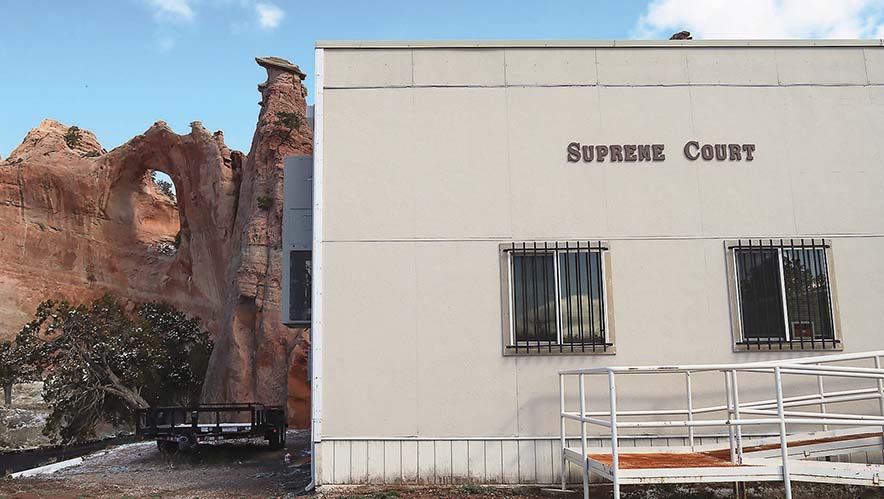
Judicial branch celebrates 65 years

Navajo Times | Boderra Joe
The Supreme Court building sits along the Window Rock monument in Window Rock on Monday.
WINDOW ROCK – The Navajo Nation Judicial Branch will celebrate its 65th anniversary with Justice Day events across the Navajo Nation in April. The events are for the public and for them to learn more about the Nation’s courts.
On behalf of Chief Justice JoAnn Jayne, Karen Francis, the Judicial Branch’s acting administrative director, said members of the Judicial Branch are looking forward to Justice Day, which celebrates the creation of the Navajo Nation’s court system on April 1, 1959.
Before the Nation had a court system, Francis, who had been with the Judicial Branch for 13 and a half years, said the Navajo Tribe was under the federal government.
According to Francis, in the 1950s, a proposal was introduced in Arizona to take over the Navajo courts using the then-newly enacted federal Public Law 280.
This allowed the Navajo Tribal Council to approve a resolution to abolish the Navajo Courts of Indian Offenses, which were courts of the Department of Interior, and acknowledge the existing courts as courts of the Navajo Tribe.
The resolution became effective April 1, 1959.
The Navajo people had their own form of dispute resolution: they discussed matters with leaders selected by community consensus.
“Hózhǫ́ǫ́ji nahat’á” is the process recognized today through the Judicial Branch’s Peacemaking Program.
There are 11 judicial districts with district and family courts and offices for the Peacemaking Program and Probation and Parole Services.
Judicial districts included Window Rock, Tuba City, Kayenta, Aneth, Shiprock, Crownpoint, Pueblo Pintado, Dilkon, Chinle, Dziłíjiin, Ramah, and Tó Hajiileehé/Alamo.
The Supreme Court hears appeals and sits in Window Rock.
Navajo Nation sovereignty
The values extend profoundly because justice and law are embedded in the Diné cultural context.
Former Chief Justice Herb Yazzie said the idea of Justice Day is a time to reflect.
“Justice is being provided, and what’s the best way for justice to be provided?” asked Yazzie, who served as chief justice from 2005 to 2015.
The Navajo government provides justice to the Nation and its people; it is more than a celebration.
Former Chief Justice Robert Yazzie said striving to balance law and justice is appropriate and worth discussing.
“It’s important because it’s when the Navajo Nation took responsibility rather than having outside law,” said Robert, who served as chief justice from 1992 to 2003. “We do have inherent power to run our own judicial system and to have our courts to have power to make decisions to our own law.”
Today, he refers to it as the Navajo Common Law.
“April first is a real special day that we are a sovereign nation and (should) act accordingly,” Robert said.
“What if one day we wake up and see that we no longer have a Navajo court system?” Robert asked. “What if our courts were placed under the complete authority of the state and federal court system?”
He added it is an inherent power that the Navajo Nation continues to use Navajo values and knowledge to provide stability, order, uniformity, and teachings through the legal system to the Navajo Nation and its people.
During his time as chief justice, Robert expressed that the Peacemaking needed to be revived.
Dempsey Harvey, the Peacemaking Program coordinator at the Judicial Branch, said the purpose of the Peacemaking Program is to alleviate contention, and its peacemakers encourage people to work together to resolve conflict in a peacemaking session.
The program uses the Diné Fundamental Law, comprising traditional law, natural law, customarily law, and custom law, according to Harvey.
This allows all leaders and educators to approach matters with involved parties to restore and resolve issues and concerns through traditional values.
The Peacemaking Program and its practices and values were woven into Diné teachings before the Long Walk, Hwéeldi, which Harvey suggests not forgetting because although it was a time of removal, the Navajo people were told not to forget about their language and cultural traditions.
“People say, ‘Well, that’s the old way of doing things. You need to get up to par on the future,’” Harvey said, adding that Diné Bizaad and the Diné traditions are still being carried on.
“We are unique, and when we invoke sovereignty, that’s a big thing of the natural law,” he added. “The Navajo Nation is big on saving our sovereignty. It is who we are as Diné, as the five-finger beings,” said Harvey, who has been with the Peacemaking Program for three years.
“The Peacemaking Program is a modeled entity,” Harvey said, meaning that other tribes are implementing their own Peacemaking Program with the help of the Navajo Nation.
Upcoming Justice Day events:
April 1
9 a.m. – 1 p.m.
Supreme Court, Window Rock District Court, Peacemaking Program, Administrative Office of the Courts, Judicial Conduct Commission, Window Rock, Arizona
April 2
TBA
Alamo Court
April 3
10 a.m. – 2 p.m.
Dziłíjiin Judicial District, Piñon, Arizona
April 5
8 a.m. – 2 p.m.
Tuba City Judicial District
9 a.m. – 2 p.m.
Chinle Judicial District, Chinle Judicial Complex Building A
10 a.m. – 3 p.m.
Ramah Judicial District
TBA
Kayenta Judicial District
April 8
TBA
Tó Hajiileehé Court
April 12
9 a.m. – 2 p.m.
Aneth Judicial District, Aneth District Court at Aneth Chapter House








 Highway 264,
Highway 264, I-40, WB @ Winslow
I-40, WB @ Winslow